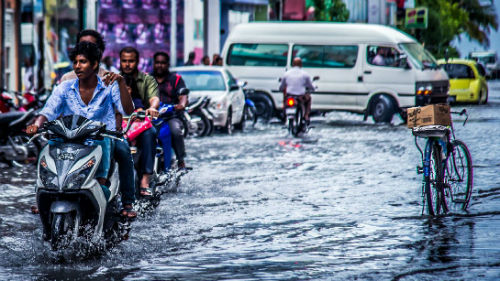Malé under water: frequent floods demonstrate climate vulnerability
A few hours of heavy rain in Malé City on Monday morning inundated streets, snarled traffic, flooded the main hospital and caused a roof to cave in at a primary school, prompting concern over the island city’s vulnerability to and lack of preparedness for extreme weather.

17 Aug 2015, 9:00 AM
A few hours of heavy rain in Malé City on Monday morning inundated streets, snarled traffic, flooded the main hospital and caused a roof to cave in at a primary school, prompting concern over the island city’s vulnerability to and lack of preparedness for extreme weather.
The showers, which lasted just over two hours, flooded the carnival area on Malé’s northeastern waterfront, just days after the army pumped out a foot of water deposited by tidal swells there.
Water leaked through the roofs at the state owned Indhira Gandhi Memorial Hospital (IGMH) and swamped its walkways and wards, in the worst flooding the hospital has seen in years. The IGMH has blamed the severity of flooding on ongoing construction.
Sections on some streets in Maafannu ward on the southwest were under a foot of water. The area, at a lower elevation than the rest of the city, is prone to frequent floods. Ameenee Magu, the city’s southern thoroughfare, was inaccessible to traffic for a time.
Become a member
Get full access to our archive and personalise your experience.
Already a member?
Discussion
No comments yet. Be the first to share your thoughts!
No comments yet. Be the first to join the conversation!
Join the Conversation
Sign in to share your thoughts under an alias and take part in the discussion. Independent journalism thrives on open, respectful debate — your voice matters.




